Date palm
| Date palm | |
|---|---|
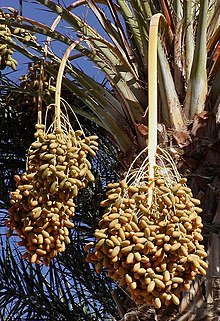
| |
| Dates on a date palm | |
| Scientific classification | |
| Kingdom: | Plantae |
| Clade: | Tracheophytes |
| Clade: | Angiosperms |
| Clade: | Monocots |
| Clade: | Commelinids |
| Order: | Arecales |
| Family: | Arecaceae |
| Genus: | Phoenix |
| Species: | P. dactylifera
|
| Binomial name | |
| Phoenix dactylifera L.
| |
| Synonyms[1] | |
| |
Phoenix dactylifera, commonly known as date or date palm,[2] is a flowering plant species in the palm family, Arecaceae, cultivated for its edible sweet fruit. The species is widely cultivated across Northern Africa, the Middle East, and South Asia, and is naturalized in many tropical and subtropical regions worldwide.[3][4][5] P. dactylifera is the type species of genus Phoenix, which contains 12–19 species of wild date palms, and is the major source of commercial production.[6]
Date trees typically reach about 21–23 metres (69–75 ft) in height,[7] growing singly or forming a clump with several stems from a single root system. Date fruits (dates) are oval-cylindrical, 3 to 7 centimetres (1 to 3 in) long, and about 2.5 centimetres (1 in) in diameter, with colour ranging from bright red to bright yellow, depending on variety. Containing 61–68 percent sugar by mass when dried,[8] dates are very sweet and are enjoyed as desserts on their own or within confections.
Dates have been cultivated in the Middle East and the Indus Valley for thousands of years. There is archaeological evidence of date cultivation in Arabia from the 6th millennium BCE. The total annual world production of dates amounts to 8.5 million metric tons, countries of the Middle East and North Africa being the largest producers.[9]
Etymology[]
The species name dactylifera "date-bearing" comes from the Greek words daktylos (δάκτυλος), which means "date" (also "finger"),[10] and fero (φέρω), which means "I bear".[11] The fruit is known as a date.[12] The fruit's English name (through Old French), as well as the Latin both come from the Greek word for "finger", δάκτυλος,[10] because of the fruit's elongated shape.
History[]
The exact place of origin of date palm is uncertain because of long cultivation, according to some sources it probably originated from the Fertile Crescent region straddling Egypt and Mesopotamia[6] while others state that they are native to the Persian Gulf area or even western India.[13] Fossil records show that the date palm has existed for at least 50 million years.[14]
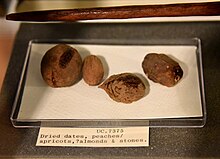
Dates have been a staple food of the Middle East and the Indus Valley for thousands of years and there is archaeological evidence of date cultivation in Mehrgarh around 7000 BCE, a Neolithic civilization in what is now western Pakistan,[15] and in eastern Arabia between 5530 and 5320 calBC.[16] and have been cultivated since ancient times from Mesopotamia to prehistoric Egypt. The ancient Egyptians used the fruits to make date wine, and ate them at harvest.[citation needed] Evidence of cultivation is continually found throughout later civilizations in the Indus Valley, including the Harappan period of 2600 to 1900 BCE.[15] The ancient Hebrews made the fruit into wine, vinegar, bread, and cakes, also using the fruit stones to fatten livestock and the wood to make utensils.[17]
In Ancient Rome the palm fronds used in triumphal processions to symbolize victory were most likely those of Phoenix dactylifera.[18] The date palm was a popular garden plant in Roman peristyle gardens, though it would not bear fruit in the more temperate climate of Italy.[19] It is recognizable in frescoes from Pompeii and elsewhere in Italy, including a garden scene from the House of the Wedding of Alexander.[20]
In later times, traders spread dates around southwest Asia, northern Africa, and Spain. Dates were introduced into Mexico and California by the Spaniards in 1765, around Mission San Ignacio.
One cultivar, the Judean date palm, is renowned for its long-lived orthodox seed, which successfully sprouted after accidental storage for 2000 years.[21] The upper survival time limit of properly stored seeds remains unknown.[22]
A genomic study from New York University Abu Dhabi Center for Genomics and Systems Biology showed that domesticated date palm varieties from North Africa, including well-known varieties such as Medjool and Deglet Nour, are a hybrid between Middle East date palms and the Cretan wild palm P. theophrasti. Date palms appear in the archaeological record in North Africa about 2,800 years ago, suggesting that the hybrid was spread by the Minoans or Phoenicians.[23]
Description[]
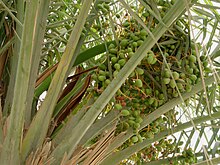
Date trees typically reach about 21–23 metres (69–75 ft) in height,[7] growing singly or forming a clump with several stems from a single root system. The leaves are 4–6 metres (13–20 ft) long, with spines on the petiole, and pinnate, with about 150 leaflets. The leaflets are 30 cm (12 in) long and 2 cm (0.79 in) wide. The full span of the crown ranges from 6–10 m (20–33 ft).
The date palm is dioecious, having separate male and female plants. They can be easily grown from seed, but only 50% of seedlings will be female and hence fruit bearing, and dates from seedling plants are often smaller and of poorer quality. Most commercial plantations thus use cuttings of heavily cropping cultivars. Plants grown from cuttings will fruit 2–3 years earlier than seedling plants.

Dates are naturally wind pollinated, but in both traditional oasis horticulture and in the modern commercial orchards they are entirely pollinated manually. Natural pollination occurs with about an equal number of male and female plants. However, with assistance, one male can pollinate up to 100 females. Since the males are of value only as pollinators, this allows the growers to use their resources for many more fruit-producing female plants. Some growers do not even maintain any male plants, as male flowers become available at local markets at pollination time. Manual pollination is done by skilled labourers on ladders, or by use of a wind machine. In some areas such as Iraq the pollinator climbs the tree using a special climbing tool that wraps around the tree trunk and the climber's back (called تبلية in Arabic) to keep him attached to the trunk while climbing.
Date fruits are oval-cylindrical, 3–7 cm (1.2–2.8 in) long, and 2–3 cm (0.79–1.18 in) diameter, and when ripe, range from bright red to bright yellow in colour, depending on variety. Dates contain a single stone about 2–2.5 cm (0.8–1.0 in) long and 6–8 mm (0.2–0.3 in) thick. Three main cultivar groups of date exist: soft (e.g. 'Barhee', 'Halawy', 'Khadrawy', 'Medjool'); semi-dry (e.g. 'Dayri', 'Deglet Nour', 'Zahdi'), and dry (e.g. 'Thoory'). The type of fruit depends on the glucose, fructose, and sucrose content.
Genome[]

In 2009, a team of researchers at the Weill Cornell Medical College in Qatar published a draft version of the date palm genome (Khalas variety).[24][25] The draft genome sequence was improved in 2019 with the release of a more complete genome sequence using small molecule real-time sequencing technology by a team from the New York University Abu Dhabi Center for Genomics and Systems Biology and the UAE University Khalifa Center for Genetic Engineering and Biotechnology in the United Arab Emirates. With the release of this improved genome assembly, the UAE researchers were able to map genes for fruit color and sugar content.[26] The NYU Abu Dhabi researchers had also re-sequenced the genomes of several date varieties to develop the first single nucleotide polymorphism map of the date palm genome in 2015.[27]
Cultivation[]
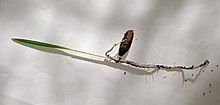

Dates are an important traditional crop throughout the Middle East and north Africa. Dates (especially Medjool and Deglet Nour) are also cultivated in the southwestern United States, and in Sonora and Baja California in Mexico.
Date palms can take 4 to 8 years after planting before they will bear fruit, and start producing viable yields for commercial harvest between 7 and 10 years. Mature date palms can produce 150–300 lb (70–140 kg)[28][29] of dates per harvest season. They do not all ripen at the same time so several harvests are required. To obtain fruit of marketable quality, the bunches of dates must be thinned and bagged or covered before ripening so that the remaining fruits grow larger and are protected from weather and animals, such as birds, that also like to eat them.
Date palms require well-drained deep sandy loam soils with a pH of 8-11 (i.e., alkali). The soil should have the ability to hold moisture and also be free of calcium carbonate.[30]
An article on date palm tree cultivation is contained in Ibn al-'Awwam's 12th-century agricultural work, Book on Agriculture.[31]
Production[]
| Top ten date producers – 2019 (tonnes) | ||
|---|---|---|
| 1,603,762 | ||
| 1,539,756 | ||
| 1,307,908 | ||
| 1,136,025 | ||
| 639,315 | ||
| 483,071 | ||
| 438,700 | ||
| 372,572 | ||
| 323,478 | ||
| 288,700 | ||
| World | 9,075,446 | |
| Source: UN Food and Agriculture Organization (FAO)[9] | ||
Cultivars[]
A large number of date cultivars and varieties emerged through history of its cultivation, but the exact number is difficult to assess. Hussain and El-Zeid[32] (1975) have reported 400 varieties, while Nixon[33] (1954) named around 250. Most of those are limited to a particular region, and only a few dozen have attained broader commercial importance. The most renowned cultivars worldwide include Deglet Noor, originally of Algeria; and of Iraq; Medjool of Morocco; Mazafati of Iran.[34]
Diseases and pests[]
A major palm pest, the red palm beetle (Rhynchophorus ferrugineus), currently poses a significant threat to date production in parts of the Middle East as well as to iconic landscape specimens throughout the Mediterranean world.
In the 1920s, eleven healthy Medjool palms were transferred from Morocco to the United States where they were tended by members of the Chemehuevi tribe[which?] in a remote region of Nevada. Nine of these survived and in 1935, cultivars were transferred to the "" in Indio, California. Eventually this stock was reintroduced to Africa and led to the U.S. production of dates in Yuma, Arizona, and Bard, California.[35]
Invasive species[]
Not all cities and countries have benefited with the date palms resilience and ease of growth. It has made the invasive species list in some parts of the United States, Canada and Australia[36][37][38] but these references are to the related but inedible Canary Island Date Palm (Phoenix canariensis).
Uses[]
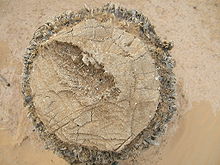
Fruits[]

Dry or soft dates are eaten out-of-hand, or may be pitted and stuffed with fillings such as almonds, walnuts, pecans, candied orange and lemon peel, tahini, marzipan or cream cheese. Pitted dates are also referred to as stoned dates. Partially dried pitted dates may be glazed with glucose syrup for use as a snack food. Dates can also be chopped and used in a range of sweet and savory dishes, from tajines (tagines) in Morocco to puddings, ka'ak (types of Arab cookies) and other dessert items. Date nut bread, a type of cake, is very popular in the United States, especially around holidays. Dates are also processed into cubes, paste called 'ajwa, spread, date syrup or "honey" called "dibs" or rub in Libya, powder (date sugar), vinegar or alcohol. Vinegar made from dates was a traditional product of the Middle East.[39][40] Recent innovations include chocolate-covered dates and products such as sparkling date juice, used in some Islamic countries as a non-alcoholic version of champagne, for special occasions and religious times such as Ramadan. When Muslims break fast in the evening meal of Ramadan, it is traditional to eat a date first.
Reflecting the maritime trading heritage of Britain, imported chopped dates are added to, or form the main basis of a variety of traditional dessert recipes including sticky toffee pudding, Christmas pudding and date and walnut loaf. They are particularly available to eat whole at Christmas time. Dates are one of the ingredients of HP Sauce, a popular British condiment.
Dates can also be dehydrated, ground and mixed with grain to form a nutritious stockfeed.
In Southeast Spain (where a large date plantation exists including UNESCO-protected Palmeral of Elche) dates (usually pitted with fried almond) are served wrapped in bacon and shallow fried.
In Israel date syrup, termed silan, is used while cooking chicken and also for sweets and desserts, and as a honey substitute.
Dates are one of the ingredients of jallab, a Middle-Eastern fruit syrup.
In Pakistan, a viscous, thick syrup made from the ripe fruits is used as a coating for leather bags and pipes to prevent leaking.

Date forks[]
In the past, sticky dates were served using specialized small forks having two metal tines, called daddelgaffel in Scandinavia.[41] Some designs were patented.[42] These have generally been replaced by an inexpensive pale-colored knobbled plastic fork that resembles a date branch (example[43]), which is traditionally included with numerous brands of prepackaged trays of dates (example), though this practice has declined in response to increased use of resealable packaging and calls for fewer single-use plastics.
Nutritional value[]
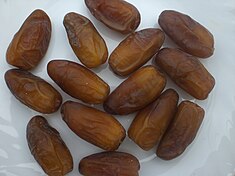 Deglet Noor dates | |
| Nutritional value per 100 g (3.5 oz) | |
|---|---|
| Energy | 1,178 kJ (282 kcal) |
75.03 g (2.647 oz) | |
| Sugars | 63.35 g (2.235 oz) |
| Dietary fiber | 8 g (0.28 oz) |
0.39 g (0.014 oz) | |
2.45 g (0.086 oz) | |
| Vitamins | Quantity %DV† |
| Vitamin A equiv. | 0% 6 μg75 μg |
| Vitamin A | 10 IU |
| Thiamine (B1) | 5% 0.052 mg |
| Riboflavin (B2) | 6% 0.066 mg |
| Niacin (B3) | 8% 1.274 mg |
| Pantothenic acid (B5) | 12% 0.589 mg |
| Vitamin B6 | 13% 0.165 mg |
| Folate (B9) | 5% 19 μg |
| Vitamin C | 0% 0.4 mg |
| Vitamin E | 0% 0.05 mg |
| Vitamin K | 3% 2.7 μg |
| Minerals | Quantity %DV† |
| Calcium | 4% 39 mg |
| Iron | 8% 1.02 mg |
| Magnesium | 12% 43 mg |
| Manganese | 12% 0.262 mg |
| Phosphorus | 9% 62 mg |
| Potassium | 14% 656 mg |
| Sodium | 0% 2 mg |
| Zinc | 3% 0.29 mg |
| Other constituents | Quantity |
| Water | 20.53 g (0.724 oz) |
| |
| †Percentages are roughly approximated using US recommendations for adults. Source: USDA FoodData Central | |
Dates provide a wide range of essential nutrients, and are a very good source of dietary potassium. The sugar content of ripe dates is about 80%; the remainder consists of protein, fiber, and trace elements including boron, cobalt, copper, fluorine, magnesium, manganese, selenium, and zinc.[44] The glycemic index for three different varieties of dates are 35.5 (khalas), 49.7 (barhi), and 30.5 (bo ma'an).[45]
The caffeic acid glycoside 3-O-caffeoylshikimic acid (also known as dactylifric acid) and its isomers, are enzymic browning substrates found in dates.[46]
Other parts[]
Seeds[]
Date seeds are soaked and ground up for animal feed. Their oil is suitable for use in cosmetics and dermatological applications. The oil contains lauric acid (36%) and oleic acid (41%). Date palm seeds contain 0.56–5.4% lauric acid. They can also be processed chemically as a source of oxalic acid. Date seeds are also ground and used in the manner of coffee beans, or as an additive to coffee. Experimental studies have shown that feeding mice with the aqueous extract of date pits exhibit anti-genotoxic effects and reduce DNA damage induced by N-nitroso-N-methylurea.[47]
Fruit clusters[]
Stripped fruit clusters are used as brooms. Recently, the floral stalks have been found to be of ornamental value in households.[48]
Sap[]

Apart from P. dactylifera, wild date palms such as Phoenix sylvestris and Phoenix reclinata, depending on the region, can be also tapped for sap.
Leaves[]
Date palm leaves are used for Palm Sunday in the Christian religion. In North Africa, they are commonly used for making huts. Mature leaves are also made into mats, screens, baskets, and fans. Processed leaves can be used for insulating board. Dried leaf petioles are a source of cellulose pulp, used for walking sticks, brooms, fishing floats, and fuel. Leaf sheaths are prized for their scent, and fibre from them is also used for rope, coarse cloth, and large hats. The leaves are used as a lulav in the Jewish holiday of Sukkot.[49] They are also commonly used as the s'chach in the construction of a sukkah.[50]
Young date leaves are cooked and eaten as a vegetable, as is the terminal bud or heart, though its removal kills the palm. The finely ground seeds are mixed with flour to make bread in times of scarcity. The flowers of the date palm are also edible. Traditionally the female flowers are the most available for sale and weigh 300–400 grams (11–14 oz). The flower buds are used in salad or ground with dried fish to make a condiment for bread.
Health benefits[]
Diabetes[]
Dates are reported to have good potential in diabetes treatment due to the presence of polyphenols exerting strong antioxidant activities.[51] They were found to reduce fasting plasma glucose and postprandial plasma glucose in a 2021 meta-analysis.[52]
Culture[]

Dates are mentioned more than 50 times in the Bible and 20 times in the Qur'an.
Many Jewish scholars believe that the "honey" reference in the Bible to "a land flowing with milk and honey" (Exodus chapter 3) is actually a reference to date "honey", and not honey from bees.[53]
In Islamic culture, dates and yogurt or milk are traditionally the first foods consumed for Iftar after the sun has set during Ramadan.
Symbolism[]
Date palms holds great significance in Abrahamic religions. The tree was heavily cultivated as a food source in ancient Israel where Judaism and subsequently Christianity developed.[54]
In the Quran, Allah instructs Maryām (the Virgin Mary) to eat dates during labour pains when she gives birth to Isa (Jesus);[55] and, similarly, they are recommended to pregnant women.[56]
In the Torah, palm trees are referenced as symbols of prosperity and triumph.[57] In Psalm 92:12 "The righteous shall flourish like the palm tree". Palm branches occurred as iconography in sculpture ornamenting the Second Jewish Temple in Jerusalem, on Jewish coins, and in the sculpture of synagogues. They are also used as ornamentation in the Feast of the Tabernacles.[54] Date palms are one of the seven species of native Israeli plants revered in Judaism.[58] The date palm has historically been considered a symbol of Judea and the Jewish people.[59]
In Christianity, palm branches were said to be scattered before Jesus as he entered Jerusalem on Palm Sunday.
References[]
- ^ The Plant List, Phoenix dactylifera L.
- ^ "Phoenix dactylifera". Germplasm Resources Information Network (GRIN). Agricultural Research Service (ARS), United States Department of Agriculture (USDA). Retrieved 10 December 2017.
- ^ Kew World Checklist of Selected Plant Families, Phoenix dactylifera
- ^ Biota of North America Project, Phoenix dactylifera
- ^ Flora of China, v 253 p 143, Phoenix dactylifera
- ^ Jump up to: a b Krueger, Robert R. "Date Palm Genetic Resource Conservation, Breeding, Genetics, And Genomics In California" (PDF). The Conference Exchange. Retrieved 26 March 2018.
- ^ Jump up to: a b Divya Bichu. "Arabian Desert Plants". Buzzle. Retrieved 19 April 2015.
- ^ "Dates, deglet noor". FoodData Central. USDA Agricultural Research Service. Retrieved 25 May 2020.
- ^ Jump up to: a b "FAOSTAT:Crops". Elements:Production Quantity / Items:Dates. Retrieved 26 March 2018.
- ^ Jump up to: a b δάκτυλος. Liddell, Henry George; Scott, Robert; A Greek–English Lexicon at the Perseus Project
- ^ fĕro. Charlton T. Lewis and Charles Short. A Latin Dictionary on Perseus Project.
- ^ "Date Palm". 15 October 2008. HowStuffWorks.com.
- ^ "Date palm". iranicaonline.org. Retrieved 6 March 2021.
- ^ "Medjool: A Date to Remember". NPR.org. 17 October 2007. Retrieved 19 April 2015.
- ^ Jump up to: a b Kenoyer, Jonathan Mark; Heuston, Kimberley Burton (2005). The Ancient South Asian World. The World in Ancient Times. Oxford University Press. ISBN 978-0-19-522243-2. Retrieved 30 July 2013.[page needed]
- ^ Tengberg, M. (November 2012). "Beginnings and early history of date palm garden cultivation in the Middle East". Journal of Arid Environments. 86: 139–147. Bibcode:2012JArEn..86..139T. doi:10.1016/j.jaridenv.2011.11.022.
- ^ Smith, Homer W. (1952). Man and His Gods. New York: Grosset & Dunlap. p. 65.
- ^ Ernest Small (2009). Top 100 Food Plants. p. 231. ISBN 9780660198583.
- ^ Linda Farrar (1998). Ancient Roman Gardens. p. 141.
- ^ Linda Farrar (1998). Ancient Roman Gardens. p. 141.
- ^ Hanson, Wendy (13 June 2008). "Date palm seed from Masada is the oldest to germinate". Los Angeles Times.
- ^ Bonner, Franklin T. (April 2008). "Chapter 4 Storage of Seeds" (PDF). Woody Plant Seed Manual, USDA FS Agriculture Handbook 727. National Seed Laboratory, 5675 Riggins Mill Rd, Dry Branch, GA 31020. Retrieved 21 June 2008.
- ^ Flowers, Jonathan; et al. (2019). "Cross-species hybridization and the origin of North African date palms". Proceedings of the National Academy of Sciences USA. 116 (5): 1651–1658. doi:10.1073/pnas.1817453116. PMC 6358688. PMID 30642962.
- ^ Date Palm Genome Drafted Science Daily, January 14, 2010, Retrieved August 30, 2010
- ^ Date Palm Draft Sequence Weill Cornell Medical College in Qatar, updated April 7, 2010, Retrieved August 30, 2010
- ^ Genome-wide association mapping of date palm fruit traits Nature Communications 10: 4680 (2019)
- ^ Whole genome re-sequencing of date palms yields insights into diversification of a fruit tree crop Nature Communications 6:8824 (2015)
- ^ "The Date, Phoenix dactylifera". Retrieved 19 April 2015.
- ^ "Publications | Extension | University of Nevada, Reno" (PDF).
- ^ "Date Palm - Phoenix dactylifera". www.growables.org. Retrieved 6 April 2019.
- ^ Ibn al-'Awwam, Yaḥyá (1864). Le livre de l'agriculture d'Ibn-al-Awam (kitab-al-felahah) (in French). Translated by J.-J. Clement-Mullet. Paris: A. Franck. pp. 321–326 (ch. 7 - Article 43). OCLC 780050566. (pp. 321-326 (Article XLIII)
- ^ Hussain, Fazal; El-Zeid, A (1975). "Studies on physical and chemical characteristics of date varieties of Saudi Arabia". Ministry of Agriculture and Water, Saudi Arabia. Cite journal requires
|journal=(help) - ^ Nixon, R.W. (1954). "Date culture in Saudi Arabia". Ann. Date Growers' Instit. (31): 15–20.
- ^ Sidhu, Jiwan S. (28 February 2008). "22. Date Fruits Production and Processing". In Hui, Y. H.; Barta, József; Cano, M. Pilar (eds.). Handbook of Fruits and Fruit Processing. John Wiley & Sons. pp. 396–. ISBN 978-0-470-27648-8.
- ^ Allen, Lee (25 April 2014). "How One Indian Couple Saved 'The Fruit of Kings'". Indian Country News. Retrieved 27 February 2016.
- ^ "Phoenix canariensis (Canary Island date palm)". www.cabi.org. Retrieved 5 December 2019.
- ^ "Phoenix canariensis Profile". California Invasive Plant Council. 20 March 2017. Retrieved 5 December 2019.
- ^ "Canary Island date palm: Phoenix canariensis (Arecales: Arecaceae): Invasive Plant Atlas of the United States". www.invasiveplantatlas.org. Retrieved 5 December 2019.
- ^ Das, Bhagwan; Sarin, J. L. (1936). "Vinegar from Dates". Industrial & Engineering Chemistry. 28 (7): 814. doi:10.1021/ie50319a016.
- ^ Forbes, Robert James (1971). "Studies in Ancient Technology". Cite journal requires
|journal=(help) - ^ dragonflywink. "Jensen fork". Silver Salon Forums. SM Publications. Retrieved 19 April 2020.
- ^ Official Gazette of the United States Patent Office. US Patent Office. 1953. p. 589.
- ^ "Dates in a wooden plate on a wooden table – stock image". Depositphotos. Depositphotos, Inc. Retrieved 19 April 2020.
- ^ Walid Al-Shahib, Richard J. Marshall (2003). "The fruit of the date palm: its possible use as the best food for the future?". International Journal of Food Sciences and Nutrition. 54 (4): 247–259. doi:10.1080/09637480120091982. PMID 12850886. S2CID 22298194.
- ^ Miller, CJ; Dunn, EV; Hashim, IB (2002). "Glycemic index of 3 varieties of dates". Saudi Medical Journal. 23 (5): 536–8. PMID 12070575.
- ^ Maier, VP; Metzler, DM; Huber, AF (1964). "3-O-Caffeoylshikimic acid (dactylifric acid) and its isomers, a new class of enzymic browning substrates". Biochemical and Biophysical Research Communications. 14 (2): 124–8. doi:10.1016/0006-291x(64)90241-4. PMID 5836492.
- ^ Diab, K.A; E. I. Aboul-Ela (2012). "In Vivo Comparative Studies on Antigenotoxicity of Date Palm (Phoenix Dactylifera L.) Pits Extract Against DNA Damage Induced by N-Nitroso-N-methylurea in Mice". Toxicology International. 19 (3): 279–286. doi:10.4103/0971-6580.103669. PMC 3532774. PMID 23293467.
- ^ Kiran, S (2014). "Floral Stalk on Date Palm: A New Discovery". International Journal of Agricultural Research, Innovation and Technology. 4 (2): 53–54. doi:10.3329/ijarit.v4i2.22649.
- ^ Karo, Joseph ben Ephraim (1999). The Metsudah Kitzur Shulchan Aruch. Metsudah Publications. OCLC 421411475.
- ^ "KKL Preparing for Distribution of "Schach"". Israel National News. Retrieved 5 March 2021.
- ^ Mia, Md Al-Tareq (2020). "Potentials and Safety of Date Palm Fruit against Diabetes: A Critical Review". Foods. 9 (11): 1557. doi:10.3390/foods9111557. PMC 7693939. PMID 33126433.
- ^ Mirghani, Hyder (2021). "Dates fruits effects on blood glucose among patients with diabetes mellitus: A review and meta-analysis". Pakistan Journal of Medical Sciences. 37 (4): 1230–1236. doi:10.12669/pjms.37.4.4112. PMC 8281151. PMID 33126433.
- ^ [1], JEWISH ACTION Magazine, Winter 5765/2005 issue
- ^ Jump up to: a b James Hastings (1909). Dictionary of the Bible. The Monist. p. 675.
- ^ The Quran, Chapter 19 - verses 22-25, retrieved on Feb. 28 2015, So she [Virgin Mary] conceived him, and she retired with him to a remote place. And the pains of childbirth drove her to the trunk of a palm tree. she cried (in her anguish): 'Ah! would that I had died before this! would that I had been a thing forgotten and out of sight!' But (a voice) cried to her from beneath the (palm-tree): 'Grieve not! for thy Lord hath provided a rivulet beneath thee; And shake towards thyself the trunk of the palm-tree; it will let fall fresh ripe dates upon thee.'
- ^ Islam Q & A, question # 214222: Does Islam recommend any particular foods to maintain a woman’s good health during pregnancy?, retrieved on Feb. 28 2015
- ^ Psalm 92.12
- ^ Cooper, John (1993). Eat and be satisfied : a social history of Jewish food. Northvale, N.J.: Jason Aronson. ISBN 0-87668-316-2. OCLC 27266322.
- ^ Jerusalem und die Länder : Ikonographie, Topographie, Theologie ; Festschrift für Max Küchler zum 65. Geburtstag. Max Küchler, Gerd Theissen. Göttingen: Vandenhoeck & Ruprecht. 2009. ISBN 978-3-525-53390-1. OCLC 457130327.CS1 maint: others (link)
External links[]
| Wikimedia Commons has media related to Phoenix dactylifera. |
| Wikisource has the text of the 1911 Encyclopædia Britannica article Date Palm. |
- INC, International Nut and Dried Fruit Council Foundation
- Date Palm Cultivation (Food and Agriculture Organization)
- Date Palm Products (additional information from the FAO)
- Date Palm entry in Encyclopaedia Iranica
- Date palm
- Desert fruits
- Drought-tolerant trees
- Edible palms
- Garden plants of Africa
- Garden plants of Asia
- Ornamental trees
- Phoenix (plant)
- Plants described in 1753
- Trees of Africa
- Tropical agriculture
- Tropical fruit
- Fruit trees
- Plants in the Bible